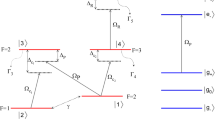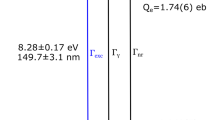Abstract
A method is proposed for the creation of an entangled metastable (subradiance) excited state in a system of two closely spaced identical atoms. The system of unexcited atoms is first placed in a magnetic field that is directed at a magic angle of \({\alpha _0} = {\text{arccos}}\left( {1/\sqrt 3 } \right) \approx 54.7^\circ \) to the line connecting the atoms and has a transverse gradient. The gradient of the field results in the detuning of frequencies of an optical transition of the atoms. Then, the resonant laser excitation of an atom with a higher transition frequency is performed with the subsequent adiabatic switching-off of the gradient of the magnetic field. It is shown that the excited atomic system in this case transits with overwhelming probability to an entangled subradiance state. Requirements on the spectroscopic parameters of the transitions and on the rate of varying the gradient of the magnetic field necessary for the implementation of this effect are analyzed.
Similar content being viewed by others
References
R. H. Dicke, Phys. Rev. 93, 99 (1954).
I. V. Bagratin, B. A. Grishanin, and V. N. Zadkov, Phys. Usp. 44, 597 (2001).
Z. Ficek and R. Tanaś, Phys. Rep. 372, 369 (2002).
R. H. Lehmberg, Phys. Rev. A 2, 889 (1970).
P. W. Milloni and P. L. Knight, Phys. Rev. A 10, 1096 (1974).
D.-W. Wang, Z.-H. Li, H. Zheng, and S.-Y. Zhu, Phys. Rev. A 81, 043819 (2010).
A. A. Makarov and V. S. Letokhov, J. Exp. Theor. Phys. 97, 688 (2003).
E. S. Redchenko and V. I. Yudson, Phys. Rev. A 90, 063829 (2014).
I. V. Bagratin, B. A. Grishanin, and V. N. Zadkov, Fortschr. Phys. 48, 637 (2000).
M. O. Scully, Phys. Rev. Lett. 115, 243602 (2015).
D. Pavolini, A. Crubellier, P. Pillet, L. Cabaret, and S. Liberman, Phys. Rev. Lett. 54, 1917 (1985).
R. G. DeVoe and R. G. Brewer, Phys. Rev. Lett. 76, 2049 (1996).
W. Guerin, M. O. Araújo, and R. Kaiser, Phys. Rev. Lett. 116, 083601 (2016).
L. D. Landau and E. M. Lifshits, Course of Theoretical Physics, Vol. 3: Quantum Mechanics: Non-Relativistic Theory (Fizmatlit, Moscow, 1963, p. 119; Pergamon, Oxford, 1965, p. 91).
A. A. Makarov, Phys. Rev. A 92, 053840 (2015).
P. Horwitz, Appl. Phys. Lett. 26, 306 (1975).
N. D. Scielzo, J. R. Guest, E. C. Schulte, I. Ahmad, K. Bailey, D. L. Bowers, R. J. Holt, Z.-T. Lu, T. P. O’Connor, and D. H. Potterveld, Phys. Rev. A 73, 010501 (2006).
H. J. Mamin, M. Poggio, C. L. Degen, and D. Rugar, Nat. Nanotechnol. 2, 301 (2007).
S. Nascimbene, N. Goldman, N. R. Cooper, and J. Dalibard, Phys. Rev. Lett. 115, 140401 (2015).
B. Dubetsky and P. R. Berman, Phys. Rev. A 66, 045402 (2002).
D. N. Yanyshev, V. I. Balykin, Y. V. Vladimirova, and V. N. Zadkov, Phys. Rev. A 87, 033411 (2013).
Author information
Authors and Affiliations
Corresponding author
Additional information
Original Russian Text © A.A. Makarov, V.I. Yudson, 2017, published in Pis’ma v Zhurnal Eksperimental’noi i Teoreticheskoi Fiziki, 2017, Vol. 105, No. 3, pp. 193–197.
Rights and permissions
About this article
Cite this article
Makarov, A.A., Yudson, V.I. Magnetic-field control of subradiance states of a system of two atoms. Jetp Lett. 105, 205–209 (2017). https://doi.org/10.1134/S0021364017030109
Received:
Published:
Issue Date:
DOI: https://doi.org/10.1134/S0021364017030109




